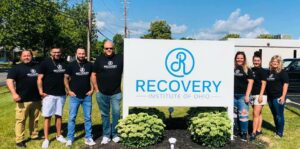Synthetic Opioids
What Are Synthetic Opioids?
Synthetic Opioids are a class of drug manufactured in laboratories and designed to have a chemical structure which is similar to Opioids naturally derived from the Opium poppy. Though the chemical makeup is similar between Synthetic Opioids and “natural” varieties (like many prescription Opioids), the specific compounds that make up Synthetic Opioids are entirely man-made — typically in a pharmaceutical laboratory. This is different than natural or non-Synthetic Opioids like Morphine and Codeine, which are extracted from naturally occurring chemicals in Opium pods, then refined and made into medication.
Frequently, Synthetic Opioids are used as cutting agents in other drugs (especially Heroin and Cocaine) or pressed into pill form and sold on the street as counterfeit Painkillers. Because Synthetic Opioids are so powerful, accidental overdose is common.
Online Addiction Counseling
Get professional help from an online addiction and mental health counselor from BetterHelp.
- Access to Therapy 24/7
- Easy Online Scheduling
- 20,000+ Licensed Therapists
Paid Advertising. We may receive advertising fees if you follow links to the BetterHelp site.
One of the most common Synthetic Opioids in the US is Fentanyl. First discovered in 1974 by Paul Janssen, the powerful drug (50 to 100 times more potent than Morphine) became one of the most widely used Opioids in medicine by 2017. The drug is produced in high quantities by both pharmaceutical companies for legal, surgical purposes and by illicit street manufacturers for illegal distribution. Today, there are a number of Fentanyl analogues, or slight variations with harsher effects on the body, being introduced with no prior or current medical use.
Other Synthetic Opioids include:
- Tramadol
- Methadone
- Carfentanil
- Acetylfentanyl
- Butyrylfentanyl
- Furanylfentanyl
- 3-Methylfentanyl
- U-47700
Carfentanil, in particular, is one of the strongest Opioids; it is 10,000 times more powerful than Morphine and was created to be an elephant Tranquilizer. A powder form of the drug is being used as a deadly cutting agent in Heroin. The rise in illicit use of Synthetic Opioids has further increased already record-high numbers of Opioid overdose deaths in the US.
Featured Centers Offering Therapy For Synthetic Opioids


Synthetic Opioids And The Opioid Epidemic
Between 2017 and 2018, fatal drug overdoses increased by 10% in the US, climbing to a total of over 72,000 Americans. The rise of even deadlier Synthetic Opioids has contributed to a majority of the still-growing death toll. In 2016, Fentanyl and other Synthetic Opioids overtook prescription Opioids in involvement in overdose fatalities. A government survey by telephone revealed that 2.1 million Americans qualified as having Opioid Use Disorder (OUD) — startling, considering 4 out of 5 Heroin addictions began with prescription Opioid abuse.
Deaths from prescription Opioids began to level off in 2011, or even reverse, in many parts of the country. However, Synthetic Opioids have added fuel to the fire. In what is commonly considered the “Second Wave” of the Opioid epidemic, drug trafficking organizations began using Synthetic Opioids to mimic other drugs. Fentanyl and drugs like it are typically sold on the street as a counterfeit for popular medications (usually Oxycodone or Hydrocodone). Addiction sufferers often believer they are purchasing OxyContin or Vicodin but are actually receiving much more powerful and fast-acting analogues with higher likelihoods of overdose.
Additionally, powder drugs like Heroin and Cocaine are being mixed (or “cut”) with Fentanyl and Carfentanil, increasing the risk of fatal overdose even among individuals with high Opioid tolerances. In Cuyahoga County, home to Cleveland, the medical examiner’s office reported that 89.8% of Heroin cases involved Fentanyl. Cleveland law enforcement describe local Heroin as a “mixture of brown and white powder” similar to powder chocolate milk mix.
Synthetic Opioids’ Effect On The Body
Synthetic Opioids’ effect on the body is similar to that of other Opioids, from Percocet to Black Tar Heroin. These drugs are Opioid receptor agonists and act primarily on the brain and spinal cord. Legally prescribed Opioids are regulated by the FDA, with predetermined potencies and consistent effects on the body. However, illicit Synthetic Opioids are unregulated, and potency can vary from lab to lab and drug dealer to drug dealer.
Using Synthetic Opioids to seek stronger “highs” generally results in an escalation of symptoms with a potential for overdose. Whether administered orally through pills, sublingually (under the tongue), through nasal inhalation, smoked, or injected intravenously, the effects are much the same, although they may vary in intensity, time of onset, and method of administration.
Symptoms of Opioid abuse include:
- Feelings of euphoria
- Drowsiness
- Sedation
- Nausea
As newer, more potent Synthetic Opioids are created, standard detection tests that can distinguish between Opioids have yet to become available to coroners, emergency medical personnel, or hospitals. Still, data does not yet demonstrate that Synthetic Opioids are any more or less addictive than other Opioids.
Looking for a place to start?
Join the thousands of people that have called a treatment provider for rehab information.
Free and confidential
Available 24/7
Access to professional treatment
Synthetic Opioid Statistics
50
percent
Synthetic Opioids made up almost 50% of Opioid-related deaths in 2016 (up from 14% in 2010).
19
thousand
Synthetic Opioids contributed to over 19,413 deaths in 2016 (deaths commonly involve multiple Opioids).
Synthetic Opioid Overdose
Typically, fatal Opioid overdoses are caused by a lack of oxygen when a person stops breathing. Because Synthetic Opioids are so similar to “natural” Opioids, the signs of dependency, addiction, and overdose to both are very similar. Fentanyl is a longer-acting Opiate, like Morphine, Heroin, or Oxycodone. The primary difference between overdose from Oxycodone and Fentanyl or Carfentanil is that the latter one is exponentially stronger than the former two and therefore presents a greater risk of complications. Moreover, Fentanyl’s ability to start affecting the body soon after ingestion can lead to overdose even faster.
Signs of overdose are more pronounced versions of symptoms the drug already produces — slowed breathing may stop entirely, reduced consciousness may become unconsciousness. Today, Opioid overdose is more likely to be fatal because of high potency. However, it is possible to survive an Opioid overdose if the victim is provided medical attention quickly enough.
To reverse an overdose, and allow an individual to begin breathing normally again, high doses of Naloxone are required. Naloxone, an Opioid receptor antagonist, can block the effects of all Opioids in a person’s system, reviving them and preventing them from getting any higher. The most common form of Naloxone, Narcan, comes in a nasal spray in a 4 mg dose. Multiple doses may need to be administered to fully revive an individual.
Check if my insurance covers rehab
Addiction Center is not affiliated with any insurance.
Get Help For A Synthetic Opioid Addiction
Regardless of the type of Opioid, detoxing can be painful and — in extreme cases — deadly. Medical professionals generally recommend individuals seek assistance from a drug rehab facility, as medical assistance increases the likelihood of success as well as comfort. Followed by inpatient drug rehab or outpatient rehab, people can recover and maintain sobriety afterward through support groups or therapy.
If you’re ready to start your journey to recovery, contact a treatment provider today.
Published:
Author
Destiny Bezrutczyk

-
Destiny Bezrutczyk is a Digital Content Writer from west Iowa. She earned a Bachelor’s in English Language and Literature from Texas Tech University. After working as a freelance script and blog writer, she began writing content for tech startups. Maintaining a passion for words, she took on a variety of projects where her writing could help people (especially those battling mental health and substance use disorders).
- More from Destiny Bezrutczyk
Reviewed by Certified Addiction Professional:
Theresa Parisi

Theresa Parisi is a Certified Addiction Professional (CAP), Certified Behavioral Health Case Manager (CBHCM), and International Certified Alcohol and Drug Counselor (ICADC) with over 12 years of experience in the addiction treatment field.
- More from Theresa Parisi
Sources


Recovery Starts Today
Call Now For Addiction Support


Banyan Treatment Centers – Chicago
Chicago , IL

Recovery Centers of America at St. Charles
St. Charles , IL

Banyan Treatment Centers – Illinois
Gilman , IL

Beloit Comprehensive Treatment Center
Beloit , WI

Madison East Comprehensive Treatment Center
Madison , WI

Recovery Centers of America at Indianapolis
Indianapolis , IN

Options Behavioral Health Hospital
Indianapolis , IN

Ridgeview Behavioral Hospital
Middle Point , OH

Boca Recovery Center – Indiana
Bloomington , IN



Evansville Comprehensive Treatment Center
Evansville , IN


Georgetown Behavioral Hospital
Georgetown , OH
